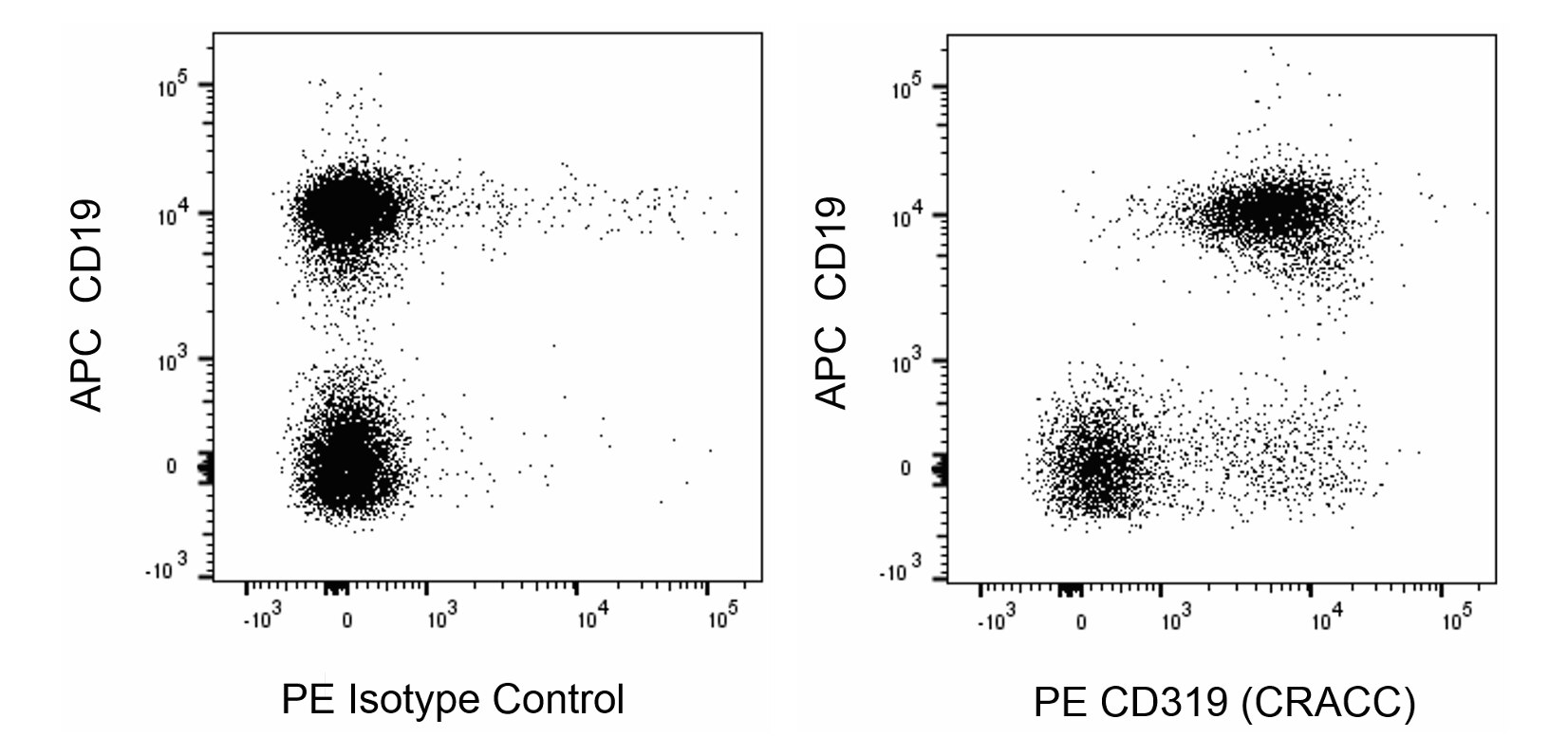Old Browser
This page has been recently translated and is available in French now.
Looks like you're visiting us from {countryName}.
Would you like to stay on the current country site or be switched to your country?


.png)

Two-color flow cytometric analysis of CD319 (CRACC) expression on mouse splenocytes. C57BL/6 mouse splenic leucocytes were preincubated with Purified Rat Anti-Mouse CD16/CD32 antibody (Mouse BD Fc Block™) (Cat. No. 553141/553142). The cells were then stained with APC Rat Anti-Mouse CD19 antibody (Cat. No. 550992/561738) and either PE Rat IgG1, κ Isotype Control (Cat. No. 553925; Left Plot) or PE Rat Anti-Mouse CD319 antibody (CRACC) (Cat. No. 566659; Right Plot) at 0.5 µg/test. Two-color flow cytometric dot plots showing the correlated expression of CD319 (CRACC) or Ig Isotype Control staining versus CD19 were derived from gated events with the forward and side light-scatter characteristics of viable leucocytes. Flow cytometric analysis was performed using a BD LSRFortessa™ X-20 Flow Cytometer System. Data shown on this Technical Data Sheet are not lot specific.
.png)

BD Pharmingen™ PE Rat Anti-Mouse CD319 (CRACC)
.png)
Regulatory Status Legend
Any use of products other than the permitted use without the express written authorization of Becton, Dickinson and Company is strictly prohibited.
Preparation And Storage
Product Notices
- Since applications vary, each investigator should titrate the reagent to obtain optimal results.
- An isotype control should be used at the same concentration as the antibody of interest.
- Caution: Sodium azide yields highly toxic hydrazoic acid under acidic conditions. Dilute azide compounds in running water before discarding to avoid accumulation of potentially explosive deposits in plumbing.
- For fluorochrome spectra and suitable instrument settings, please refer to our Multicolor Flow Cytometry web page at www.bdbiosciences.com/colors.
- Please refer to www.bdbiosciences.com/us/s/resources for technical protocols.
Companion Products




.png?imwidth=320)

The 4G2 monoclonal antibody specifically recognizes CD319 which is also known as CD2-like receptor activating cytotoxic cells (CRACC), Signaling lymphocytic activation molecule 7 (Slamf7), or novel Ly9. CD319 (CRACC) is a single-pass type I transmembrane glycoprotein that is encoded by Slamf7 (SLAM family member 7) which belongs to the SLAM family within the CD2-subset of the immunoglobulin superfamily (IgSF) of cell surface receptors. This receptor is comprised of an extracellular region with one N-terminal Ig-like V-type (IgV) domain followed by one Ig-like C2-type (IgC2) domain. Its cytoplasmic tail contains two immunoreceptor tyrosine-based switch motifs (ITSMs). This receptor is variably expressed on activated CD4+ T cells and CD8+ T cells, NKT cells, NK cells, B cells, monocytes, macrophages, and dendritic cells. CD319 (CRACC) serves as a homotypic adhesion molecule that can self-associate and trigger cellular activation, such as cell-mediated cytotoxicity, when its cytoplasmic domains are associated with adaptor molecules including EWS-activated transcript 2 (EAT-2) and possibly EAT-2-related transducer (ERT). In cells that lack EAT-2, CD319 (CRACC) may exhibit an inhibitory function.

Development References (2)
-
Cruz-Munoz ME, Dong Z, Shi X, Zhang S, Veillette A. Influence of CRACC, a SLAM family receptor coupled to the adaptor EAT-2, on natural killer cell function.. Nat Immunol. 2009; 10(3):297-305. (Immunogen: Flow cytometry). View Reference
-
Guo H, Cruz-Munoz ME, Wu N, Robbins M, Veillette A. Immune cell inhibition by SLAMF7 is mediated by a mechanism requiring src kinases, CD45, and SHIP-1 that is defective in multiple myeloma cells.. Mol Cell Biol. 2015; 35(1):41-51. (Clone-specific: Flow cytometry, Functional assay, Immunoprecipitation). View Reference
Please refer to Support Documents for Quality Certificates
Global - Refer to manufacturer's instructions for use and related User Manuals and Technical data sheets before using this products as described
Comparisons, where applicable, are made against older BD Technology, manual methods or are general performance claims. Comparisons are not made against non-BD technologies, unless otherwise noted.
For Research Use Only. Not for use in diagnostic or therapeutic procedures.